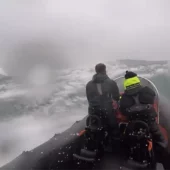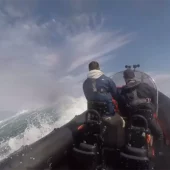>> 1 minute read time
How to Navigate in Rough Waters
Training for the sea requires a strong foundation in both theory and hands-on skills.
Venturing out safely, especially with loved ones, demands a well-rounded and proven knowledge of maritime conditions.
Being at the helm means handling any sea state with confidence and reliability—because the sea isn’t something to take lightly.
You, as a skipper, are responsible for everything and everyone on board. Check beforehand your for instance the safety equipment and the weather forecast. Verify the fuel and radio. Inspect the condition of your RIB and engine.
Ensure alarm signals and the fire extinguisher are ready to use.
It’s only logical to do it every time you go out, whether it’s in rough waters or as calm as a mer d’huile, as the French so beautifully put it.
If you need to know more, check out these articles:
- Safe Passenger Transport on RIBs: 7 Essentials
- What Safety Equipment is Essential for RIBs?
- How Do I Navigate Shallow Waters in a RIB: 10 Tips
- How Do I Protect my RIB from UV Damage
- What Engine Maintenance Tips Apply to RIBs
Now, Back to the Rough Waters Video
This training by OLM Perfectionnement Mer Formée includes a technical demo.
The demo focuses on navigating currents in a Rigid Inflatable Boat near Raz de Sein, Brittany, France.
It is close to landmarks like the “La Vieille” lighthouse and the west cardinal buoy, “La Plate.”
Equipment Used During this Training
- Ribcraft 6.40
- Mercury 200 ProXS V8
- Garmin GPSMAP 1223
- Shoxs 5005-5705.
Proud to share that RIBCRAFT UK is a Friend of RIBs ONLY.



